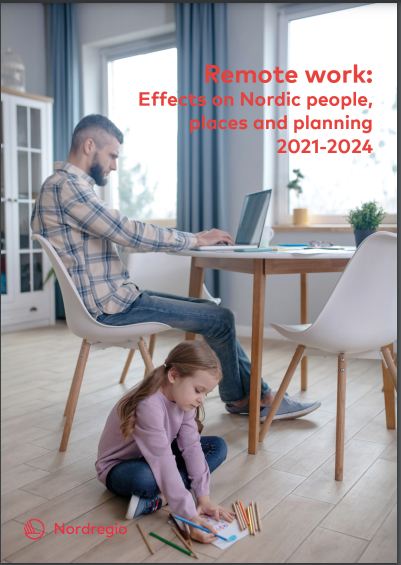This report is the first outcome of the project Remote work: Effects on Nordic people, places and planning 2021-2024. This report provides a broad understanding of the current situation (May, 2022) regarding remote work in the Nordic countries, particularly in relation to potential urban and regional development effects. It provides insight into emerging trends in the countries based on Nordic research, statistical data, and stakeholder interviews. Further, it considers the national level policy frameworks that “set the stage” for the development of remote work practices in the Nordic countries.
Our findings suggest that higher levels of remote work are likely to be maintained in the long term in all Nordic countries, at least to some degree. Importantly, however, there is little evidence to support a large-scale shift towards a “remote first” mindset among Nordic workers or workplaces. This means that, for the majority of workers and workplaces, the most likely scenario will be some form of hybrid arrangement. The effectiveness of these arrangements in promoting wellbeing and quality of life for workers, as well as the extent to which collaboration and innovation thrive under hybrid conditions, will both be key factors in determining whether remote work remains more common in the long term.
From a spatial perspective, the patterns of migration, mobility and multilocality observed in the Nordic countries during the pandemic support the idea that increased remote work will have implications for planners in Nordic cities, regions, and rural areas. Daily commuting became less common and internal migration patterns suggest that this has been accompanied by a willingness to travel further. Some rural municipalities also appear to have become more desirable. This is evidenced by the slowing, or even reversal, of trends towards population decline and also by increased demand for and use of second homes. If these trends continue, they could present substantial opportunities for positive development in some rural areas as well as for smaller cities in proximity to larger urban centres.
Although the experience of remote work during the pandemic has been relatively similar in all Nordic countries, the future direction varies somewhat in light of the pre-existing policy context in each country. In Iceland, the pandemic has given momentum to the existing regional policy priority of encouraging state jobs without specified placement. Similarly, in Finland, increased remote work fits well with the pre-pandemic focus on combating depopulation and ageing in rural municipalities through increased multilocality. In Sweden, Norway, and Denmark, the links between regional policy and remote work are less clear. At the same time, the preconditions for increased remote work are evident in all countries and the potential regional development benefits align well with broader regional policy goals.
Increased remote work in the Nordic Region should be considered in the context of the Nordic Prime Ministers vision to make the Nordic Region the most sustainable and integrated in the world by 2030 (Norden, n.d.). From a social sustainability perspective, it is important to acknowledge that most workers do not have the possibility to work remotely and, even for those who do, the advantages and disadvantages will differ between groups. From a spatial perspective, getting the most out of the opportunities increased remote work offers for smaller cities and rural areas will require careful planning that balances the needs of newcomers, temporary residents, and the existing population. Economic sustainability is an important consideration here, particularly in the case where a person’s life and work are split between two or more municipalities. From an environmental sustainability perspective, it is important not to assume that remote work is inherently coupled with favourable environmental outcomes. While it may reduce the need for travel, the lifestyle choices remote work enables may be accompanied by negative environmental impacts such as increased resource use and travelling longer
distances through less environmentally friendly means.
Overall, it appears that the experiences of remote work during the pandemic have been fairly similar in the five Nordic countries. Similar trends are also evident, though to differing degrees, with respect to the effects on different places throughout the region. The most notable differences between the countries relate to the regional policy responses, and it is perhaps here that the greatest potential for Nordic added value emerges. The next stages of the project will dig deeper into the ways in which these similarities and differences play out at the local and regional levels as we continue to explore the effect of remote work on Nordic people, places, and planning.














